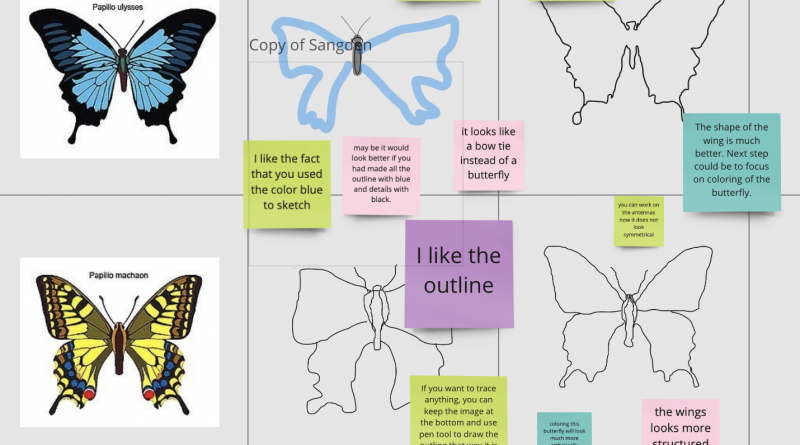All About Feedback
All About Feedback
Based on this video Austin’s butterfly by EL education we decided to facilitate a session for our community of educators on Feedback culture in classrooms.
In the short video, Ron Berger shares a student project with elementary school students to illuminate the power of critique and multiple drafts. The activities in the session brought about some really interesting ways the teachers have been using feedback in their classrooms.
Here are some images of teacher’s iterations and comments on butterflies.
Here is the link to Miro board used during the session:
https://miro.com/app/board/uXjVOemRTt4=/?invite_link_id=26419434423
We decided to take some time out to talk to 2 of the teachers to find out more.
Anu Shrestha is an educator and an instructional designer. She has spent the last five years designing STEM-based educational programs and activity-based instructional activities. She has also spent some time travelling to different parts of Nepal conducting programs related to design thinking and STEM education. Currently, she is teaching science to primary students, while pursuing her master’s degree at Kathmandu University School of Education in TVET Education.
Rupesh Bhattarai is a writer and educator based in Kathmandu. Rupesh is interested in fostering critical thinking skills in students using tools of STEAM education and literary arts. Rupesh is also a spoken word poet who has participated and won in several national and international level poetry slams. His works have been published on various Nepali and international media platforms.
Question: What is good feedback?
Anu: A good feedback is the kind of honest feedback which helps the receiver of the feedback to see the positive sides and realize the aspects to improve upon. I think positive feedback should also include new ideas and suggestions.
Rupesh: Good feedback is the kind of feedback that gives the receiver the right kind of advice. Depending on the practice and the level of the recipient, good feedback provides them with a way forward. It could be telling a kid learning math to start looking at algebraic expressions like mathematical statements or pointing out that a singer was missing out on certain notes.
Q: How do we teach students to give good feedback?
Anu: One way in which I help the students to give good and constructive feedback is by modeling the questions to think about such as:
- What aspect of the project did you really like/enjoy?
- If you were to make some changes in this, what would you change?
- What did you feel by looking at it?
- How relevant did you think this is?
- Did you observe teamwork/hardwork in this project?
Rupesh : A lot of it should be actively modeled by the teacher. While a lot of intentional teaching of proper feedback can be done in regular conversations and activities, the teacher should also have time in the classroom where they declare that they are going to offer feedback to their students and ask them to notice what the feedback is and how it is being given.
Q: In what ways do you integrate feedback in your classroom to help student learning?
Anu: In my classroom I integrate feedback in following ways:
- Students generally rate the classroom engagement, the difficulty of a test paper and presentation given by other students or groups on the scale of 1-5.
- A written form of feedback is practiced while checking the copies of the students. Although I don’t give feedback on each and every copy, I put notes on the copies after correction in both the cases where they have done something good or when they really need to improve on something.
- Students also provide written feedback on paper to their pairs during the project showcase and group works.
Rupesh: I generally give feedback to the class as a whole if most of the students need similar feedback. For more important and crucial feedback, I choose in-person conversations or notes. There are also times when I ask students to actively criticize each other’s work.
Q: How do students usually react to feedback? Is there a difference between receiving feedback from teachers versus receiving it from their peers?
Anu: Students generally are open to feedback if given in a proper way, without discouraging them. It sometimes helps them to realize things on their own.
I think there is definitely a difference between receiving feedback from teachers vs. their peers. As my observation, students tend to work on the feedback by teachers more seriously as compared to the feedback from their peers. I think this is also the case, because the peers struggle to articulate their feedback properly and sometimes it’s not well thought out.
Rupesh: The students generally react well to teacher feedback and work on it, but not all teacher feedback is definitive, some of it is subjective and the way our classrooms are structured, the possibility of a student choosing the teacher’s suggestion over their own expression is high. Students generally don’t like comments from their peers especially in informal situations, and it sometimes also causes a lot of friction.
Q: How do you teach students to receive feedback positively?
Anu: I once gave my students the analogy of a gift/present to make them more open towards receiving feedback. Here I shared with the students how feedback is like a present you should always receive happily, even when you don’t like it. But once you receive it, it is upto them to put the worth into it. If they like the feedback they can use it like the best gifts and if you don’t like the feedback you can always put it in the corner of your cupboard until you need it, or just throw it away.
Rupesh: 1. By explaining that peer feedback is an effective learning method and it often helps even more than a classroom lecture.
2. By asking the students to separate themselves from their work.
Q: Can you share an instance when your students were good at giving/taking the feedback?
Anu: This one time we did a mini-showcase of the project works made by the students. During this, the observers were asked to provide feedback to the students after observing the work of the students. Later, when I sneaked into reading those feedback, some of them were really insightful.
Rupesh: Students give a lot of feedback to the teachers indirectly. If a class activity works/is engaging, the students request that the teacher keep facilitating similar activities in the classroom. In my classrooms, students often remind me to use digital and physical tools to make the class more engaging. Recently, I also read a story that I had written to a class and got them to give me feedback on how I could make the story even more interesting for people their age.



